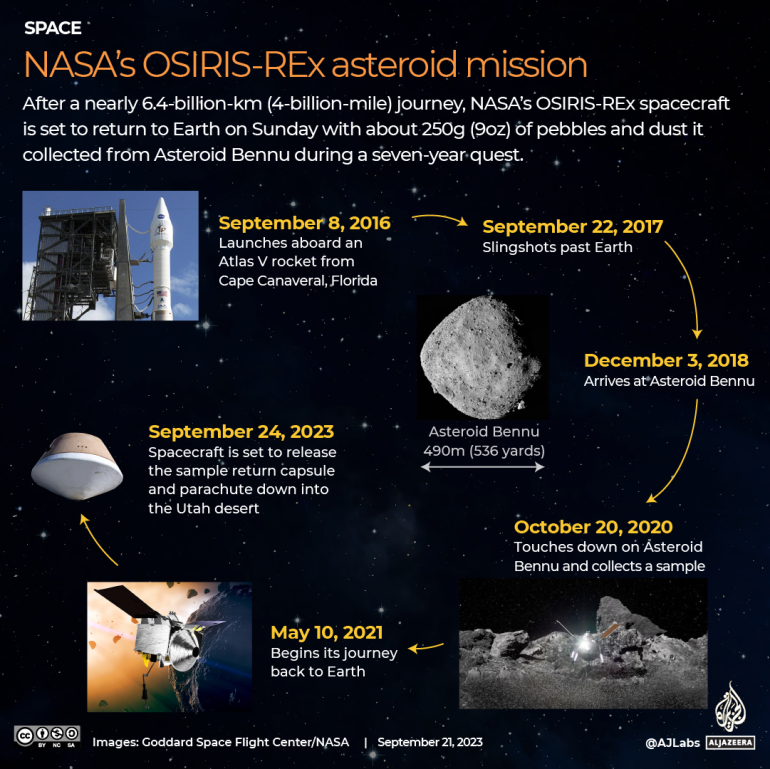NASA’s OSIRIS-REx to bring samples of asteroid Bennu to Earth: What to know | Explainer News
A space capsule carrying a sample of rocky material removed from the surface of an asteroid three years ago is expected to make a parachute landing in the Utah desert on Sunday.
If successful, the OSIRIS-REx mission, a joint effort between NASA and scientists at the University of Arizona, would mark the third asteroid sample, and by far the largest, ever returned to Earth for analysis.
OSIRIS-REx collected its samples from Bennu, a carbon-rich asteroid, before embarking on a 1.9-billion-km (1.2-billion-mile) journey back to Earth in May 2021.
What is the OSIRIS-REx?
The Origins, Spectral Interpretation, Resource Identification, Security-Regolith Explorer (OSIRIS-REx) is an unmanned spacecraft from NASA that was sent to collect samples from Bennu.
The spacecraft was equipped with cameras to capture images that were essential to collecting samples from the asteroid during the mission. It was also equipped with materials to develop 3D maps of Bennu, measure its temperature, map its mineral and chemical composition, and view it in X-rays and infrared light.
The robotic arm attached to the spacecraft collected loose rocks and dirt from the asteroid’s surface, which were then sealed inside the sample return capsule.
This capsule separated from the spacecraft and began its fiery plunge through Earth’s atmosphere.

What do we know about the spacecraft’s journey?
The OSIRIS-REx launched from Florida on September 8, 2016.
In September 2017, the spacecraft used the help of the Earth’s gravity to propel itself on its long journey towards Bennu, reaching the asteroid on December 3, 2018.
It made contact with the surface of the asteroid for about five seconds on October 20, 2020. The sample collection was made over three attempts by OSIRIS-REx.
In May 2021, the spacecraft began its journey back to Earth.
Where and when will the sample land on Earth?
The sample is expected to return to Earth on Sunday at 14:55 GMT.
The capsule containing the sample will parachute down to the Utah Test and Training Range in Utah’s West Desert, where scientists will be waiting to retrieve it.
Are the asteroid samples dangerous?
The sample will not contain contaminants such as viruses or bacteria, according to Harold Connolly, who is based at Rowan University and is the OSIRIS-REx mission sample scientist and a co-investigator.
He made a comparison with material taken from Apollo 11 lunar samples, which caused similar concerns at the time. After using animals to test that material, it was declared safe.
No microbial growths were found and NASA decided it was safe enough to stop further animal testing or quarantining astronauts and lab technicians working with lunar samples after the Apollo 14 mission in 1971.
What do we know about Bennu?
Bennu, previously called 1999 RQ36, was discovered in 1999 and classified as a “near-Earth object” because it passes relatively close to our planet every six years. It is a small asteroid, a little less than 500 metres in depth and is more than 4.5 billion years old.
Over time, the asteroid has drifted closer to Earth, closely approaching it every six years. Scientists estimate that one of these close approaches has a small chance of impacting the Earth on September 24, 2182.
Why was OSIRIS-REx sent to Bennu?
The mission was launched so that scientists could learn how to better predict the long-term risks of near-Earth asteroids such as Bennu hitting our planet.
Scientists also believe that within 10 million years of the solar system’s formation, Bennu’s present-day chemical and mineral composition was already formed.
Telescopes have shown that the asteroid contains carbon-rich organic material, which may have played a role in delivering life-forming compounds to Earth. Part of OSIRIS-REx’s mission was to learn more about these compounds.
Scientists have also hoped to determine if there are any signs of water on the asteroid, and to investigate whether hydrogen and oxygen can be extracted from the water on asteroids to fuel rockets in space.
With just days left before the #OSIRISREx sample return, let’s do a quick refresher on @NASA‘s first-ever asteroid sample return mission! 🧵 pic.twitter.com/J1HEWzJqaG
— NASA Goddard (@NASAGoddard) September 21, 2023
What will happen to the OSIRIS-REx spacecraft after the mission?
The OSIRIS-REx spacecraft will be renamed to OSIRIS-APEX (OSIRIS-APophis Explorer) and be sent to study another near-Earth asteroid, Apophis, when it comes close to the Earth in 2029.
“It’s a perfectly viable spacecraft that can do more science, and NASA was wise to repurpose it and get new science out of it by going to Apophis,” said Connolly.
How can I follow the landing?
You can watch the live coverage of the OSIRIS-REx capsule landing on Sunday using the NASA Live link.




